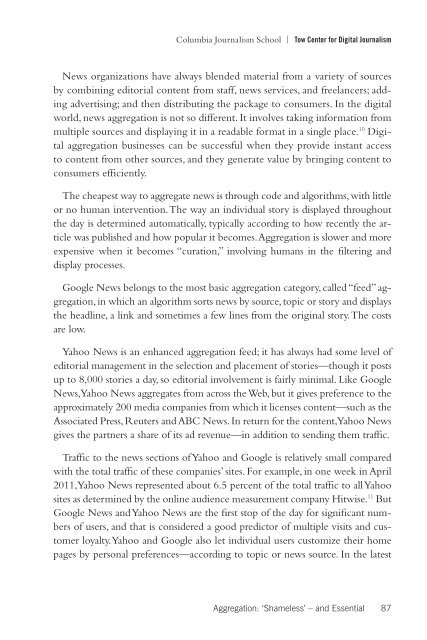What We Know About the Business of Digital Journalism
What We Know About the Business of Digital Journalism
What We Know About the Business of Digital Journalism
You also want an ePaper? Increase the reach of your titles
YUMPU automatically turns print PDFs into web optimized ePapers that Google loves.
Columbia <strong>Journalism</strong> School | Tow Center for <strong>Digital</strong> <strong>Journalism</strong>News organizations have always blended material from a variety <strong>of</strong> sourcesby combining editorial content from staff, news services, and freelancers; addingadvertising; and <strong>the</strong>n distributing <strong>the</strong> package to consumers. In <strong>the</strong> digitalworld, news aggregation is not so different. It involves taking information frommultiple sources and displaying it in a readable format in a single place. 10 <strong>Digital</strong>aggregation businesses can be successful when <strong>the</strong>y provide instant accessto content from o<strong>the</strong>r sources, and <strong>the</strong>y generate value by bringing content toconsumers efficiently.The cheapest way to aggregate news is through code and algorithms, with littleor no human intervention. The way an individual story is displayed throughout<strong>the</strong> day is determined automatically, typically according to how recently <strong>the</strong> articlewas published and how popular it becomes. Aggregation is slower and moreexpensive when it becomes “curation,” involving humans in <strong>the</strong> filtering anddisplay processes.Google News belongs to <strong>the</strong> most basic aggregation category, called “feed” aggregation,in which an algorithm sorts news by source, topic or story and displays<strong>the</strong> headline, a link and sometimes a few lines from <strong>the</strong> original story. The costsare low.Yahoo News is an enhanced aggregation feed; it has always had some level <strong>of</strong>editorial management in <strong>the</strong> selection and placement <strong>of</strong> stories—though it postsup to 8,000 stories a day, so editorial involvement is fairly minimal. Like GoogleNews, Yahoo News aggregates from across <strong>the</strong> <strong>We</strong>b, but it gives preference to <strong>the</strong>approximately 200 media companies from which it licenses content—such as <strong>the</strong>Associated Press, Reuters and ABC News. In return for <strong>the</strong> content, Yahoo Newsgives <strong>the</strong> partners a share <strong>of</strong> its ad revenue—in addition to sending <strong>the</strong>m traffic.Traffic to <strong>the</strong> news sections <strong>of</strong> Yahoo and Google is relatively small comparedwith <strong>the</strong> total traffic <strong>of</strong> <strong>the</strong>se companies’ sites. For example, in one week in April2011, Yahoo News represented about 6.5 percent <strong>of</strong> <strong>the</strong> total traffic to all Yahoosites as determined by <strong>the</strong> online audience measurement company Hitwise. 11 ButGoogle News and Yahoo News are <strong>the</strong> first stop <strong>of</strong> <strong>the</strong> day for significant numbers<strong>of</strong> users, and that is considered a good predictor <strong>of</strong> multiple visits and customerloyalty. Yahoo and Google also let individual users customize <strong>the</strong>ir homepages by personal preferences—according to topic or news source. In <strong>the</strong> latestAggregation: ‘Shameless’ – and Essential 87
















